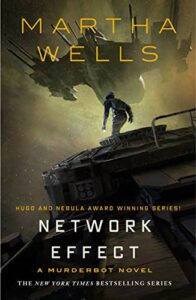Since the last time I looked in on Murderbot, it has become more secure in its freedom and found something like a home among the people of the Preservation Alliance. Preservation, as it is known throughout Network Effect, is something of a post-scarcity utopia, an interstellar polity posed as a counterpoint to Murderbot’s area of origin, the Corporation Rim. The good people of Preservation call it SecUnit, short for Security Unit, a less ominous moniker than Murderbot, indicating a more peaceful present.
Not that a reader would see that peace at the beginning of Network Effect. Wells starts out with an incipient hostage situation that shows off SecUnit’s abilities and droll affect, along with the haplessness and helplessness of mere humans, two aspects that amount to much the same thing from SecUnit’s point of view.
“I’ve also had clients who thought they didn’t need any security at all, right up until something ate them. (That’s mostly a metaphor. My uneaten client stat is high.)” (p. 9) “Mostly” and “high” rather than “perfect” are classic SecUnit modifiers, the kind that give the series much of its mordant humor.
A couple of pages later:
‘You didn’t have to shoot anyone.’ Heat crept into Thiago’s voice. ‘If you needed supplies, we [a Preservation research vessel] would have given them to you’
Don’t worry, the ‘anyone’ who got shot was me.
(Thiago, while violating the security protocol everyone agreed to IN ADVANCE, had walked out to the observation deck to greet the strangers on their stupid boat. I followed and pulled him back from the edge, and so Potential Target Leader shot me instead of him. Got me right in the shoulder. I managed to fall off the observation deck and miss the water intake. Yes, I was pissed off.) (p. 11)
SecUnit pulls itself out of the water and tears through the ship that belongs to the Potential Targets while Thiago stalls in discussions with the person SecUnit calls Potential Target Leader. Fans from previous outings will appreciate the efficient mayhem and dry commentary that SecUnit delivers, along with its exasperation about how its humans keep finding themselves in dangerous situations. This time, though, it’s a human’s actions that resolve the situation. SecUnit sets up someone else to take the wounding shot that disables Potential Target Leader and provides the opening for SecUnit to get Thiago out of harm’s way and for the team as a whole to make their escape. The SecUnit of Network Effect can work well with others, even humans.
Those abilities are put to the test, as most of the novel proceeds in an out of the frying pan and into the fire fashion, right up to the end. As the team escapes from the potential hostage situation, it is attacked in space; escaping from that, they find that their perils have instead multiplied. They are not alone in facing danger. A character from Artificial Condition has returned: a bot even more capable than SecUnit, though it is contained in and confined by the research transport ship Perihelion. In that earlier story SecUnit called it ART, Asshole Research Transport, only partly as a result of SecUnit’s general crankiness. ART is capable and, where its interests are involved, deceptive. Unfortunately for SecUnit and its humans, ART’s interests are very much involved because its crew has been taken, and ART has engaged SecUnit specifically to get them back, all other costs be damned.
What follows is a series of puzzles as the bots and humans work together to try to figure out what has happened, without getting too many of them killed. It’s also a further meditation on freedom and purpose, as the two bots, ART’s crew, and SecUnit’s humans turn out to be not the only possibilities on the continuity between people and equipment.
I think Wells may have been adjusting a bit to writing SecUnit as a novel rather than a novella; the pacing felt a bit slow in the middle, that the characters were spinning their wheels for a couple of iterations of plot without coming closer to the resolution. Not that that lasted very long, the book is a quick 350 pages. Interestingly, the bot characters are the ones who change over the course of the story. The human characters are not exactly interchangeable, but they play distinct roles, and are also distinctly secondary. The real personality developments in Network Effect are in SecUnit and ART, and the others along that continuity from thing to person. I hope Wells keeps exploring in that sector.
+++
Network Effect is the fifth Murderbot story, following four novellas, and not really a good place to start.
+++
Network Effect is a finalist for this year’s Hugo Awards. It’s the second that I have read in the Best Novel category, and the third of this year’s overall finalists that I have read. The first was Maria Dahvana Headley’s translation of Beowulf, a finalist in Best Related Work. The second was The Relentless Moon by Mary Robinette Kowal, a finalist in Best Novel.


1 pings
[…] Diaries; the fifth novella, it follows a short but unspecified amount of time after the novel Network Effect. It is not a good place to begin. The characters know each other well, and the author presumes that […]